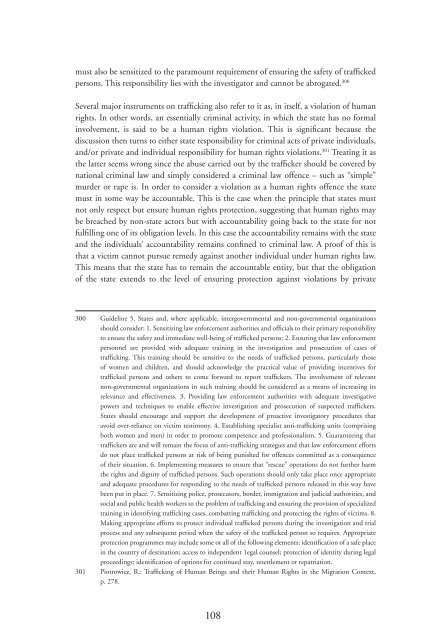Trafficking in human beings: human rights and ... - unesdoc - Unesco
Trafficking in human beings: human rights and ... - unesdoc - Unesco
Trafficking in human beings: human rights and ... - unesdoc - Unesco
You also want an ePaper? Increase the reach of your titles
YUMPU automatically turns print PDFs into web optimized ePapers that Google loves.
must also be sensitized to the paramount requirement of ensur<strong>in</strong>g the safety of traffi cked<br />
persons. This responsibility lies with the <strong>in</strong>vestigator <strong>and</strong> cannot be abrogated. 300<br />
Several major <strong>in</strong>struments on traffi ck<strong>in</strong>g also refer to it as, <strong>in</strong> itself, a violation of <strong>human</strong><br />
<strong>rights</strong>. In other words, an essentially crim<strong>in</strong>al activity, <strong>in</strong> which the state has no formal<br />
<strong>in</strong>volvement, is said to be a <strong>human</strong> <strong>rights</strong> violation. This is signifi cant because the<br />
discussion then turns to either state responsibility for crim<strong>in</strong>al acts of private <strong>in</strong>dividuals,<br />
<strong>and</strong>/or private <strong>and</strong> <strong>in</strong>dividual responsibility for <strong>human</strong> <strong>rights</strong> violations. 301 Treat<strong>in</strong>g it as<br />
the latter seems wrong s<strong>in</strong>ce the abuse carried out by the traffi cker should be covered by<br />
national crim<strong>in</strong>al law <strong>and</strong> simply considered a crim<strong>in</strong>al law offence – such as “simple”<br />
murder or rape is. In order to consider a violation as a <strong>human</strong> <strong>rights</strong> offence the state<br />
must <strong>in</strong> some way be accountable. This is the case when the pr<strong>in</strong>ciple that states must<br />
not only respect but ensure <strong>human</strong> <strong>rights</strong> protection, suggest<strong>in</strong>g that <strong>human</strong> <strong>rights</strong> may<br />
be breached by non-state actors but with accountability go<strong>in</strong>g back to the state for not<br />
fulfi ll<strong>in</strong>g one of its obligation levels. In this case the accountability rema<strong>in</strong>s with the state<br />
<strong>and</strong> the <strong>in</strong>dividuals’ accountability rema<strong>in</strong>s confi ned to crim<strong>in</strong>al law. A proof of this is<br />
that a victim cannot pursue remedy aga<strong>in</strong>st another <strong>in</strong>dividual under <strong>human</strong> <strong>rights</strong> law.<br />
This means that the state has to rema<strong>in</strong> the accountable entity, but that the obligation<br />
of the state extends to the level of ensur<strong>in</strong>g protection aga<strong>in</strong>st violations by private<br />
300 Guidel<strong>in</strong>e 5. States <strong>and</strong>, where applicable, <strong>in</strong>tergovernmental <strong>and</strong> non-governmental organizations<br />
should consider: 1. Sensitiz<strong>in</strong>g law enforcement authorities <strong>and</strong> offi cials to their primary responsibility<br />
to ensure the safety <strong>and</strong> immediate well-be<strong>in</strong>g of traffi cked persons; 2. Ensur<strong>in</strong>g that law enforcement<br />
personnel are provided with adequate tra<strong>in</strong><strong>in</strong>g <strong>in</strong> the <strong>in</strong>vestigation <strong>and</strong> prosecution of cases of<br />
traffi ck<strong>in</strong>g. This tra<strong>in</strong><strong>in</strong>g should be sensitive to the needs of traffi cked persons, particularly those<br />
of women <strong>and</strong> children, <strong>and</strong> should acknowledge the practical value of provid<strong>in</strong>g <strong>in</strong>centives for<br />
traffi cked persons <strong>and</strong> others to come forward to report traffi ckers. The <strong>in</strong>volvement of relevant<br />
non-governmental organizations <strong>in</strong> such tra<strong>in</strong><strong>in</strong>g should be considered as a means of <strong>in</strong>creas<strong>in</strong>g its<br />
relevance <strong>and</strong> effectiveness. 3. Provid<strong>in</strong>g law enforcement authorities with adequate <strong>in</strong>vestigative<br />
powers <strong>and</strong> techniques to enable effective <strong>in</strong>vestigation <strong>and</strong> prosecution of suspected traffi ckers.<br />
States should encourage <strong>and</strong> support the development of proactive <strong>in</strong>vestigatory procedures that<br />
avoid over-reliance on victim testimony. 4. Establish<strong>in</strong>g specialist anti-traffi ck<strong>in</strong>g units (compris<strong>in</strong>g<br />
both women <strong>and</strong> men) <strong>in</strong> order to promote competence <strong>and</strong> professionalism. 5. Guarantee<strong>in</strong>g that<br />
traffi ckers are <strong>and</strong> will rema<strong>in</strong> the focus of anti-traffi ck<strong>in</strong>g strategies <strong>and</strong> that law enforcement efforts<br />
do not place traffi cked persons at risk of be<strong>in</strong>g punished for offences committed as a consequence<br />
of their situation. 6. Implement<strong>in</strong>g measures to ensure that “rescue” operations do not further harm<br />
the <strong>rights</strong> <strong>and</strong> dignity of traffi cked persons. Such operations should only take place once appropriate<br />
<strong>and</strong> adequate procedures for respond<strong>in</strong>g to the needs of traffi cked persons released <strong>in</strong> this way have<br />
been put <strong>in</strong> place. 7. Sensitiz<strong>in</strong>g police, prosecutors, border, immigration <strong>and</strong> judicial authorities, <strong>and</strong><br />
social <strong>and</strong> public health workers to the problem of traffi ck<strong>in</strong>g <strong>and</strong> ensur<strong>in</strong>g the provision of specialized<br />
tra<strong>in</strong><strong>in</strong>g <strong>in</strong> identify<strong>in</strong>g traffi ck<strong>in</strong>g cases, combatt<strong>in</strong>g traffi ck<strong>in</strong>g <strong>and</strong> protect<strong>in</strong>g the <strong>rights</strong> of victims. 8.<br />
Mak<strong>in</strong>g appropriate efforts to protect <strong>in</strong>dividual traffi cked persons dur<strong>in</strong>g the <strong>in</strong>vestigation <strong>and</strong> trial<br />
process <strong>and</strong> any subsequent period when the safety of the traffi cked person so requires. Appropriate<br />
protection programmes may <strong>in</strong>clude some or all of the follow<strong>in</strong>g elements: identifi cation of a safe place<br />
<strong>in</strong> the country of dest<strong>in</strong>ation; access to <strong>in</strong>dependent 1egal counsel; protection of identity dur<strong>in</strong>g legal<br />
proceed<strong>in</strong>gs; identifi cation of options for cont<strong>in</strong>ued stay, resettlement or repatriation.<br />
301 Piotrowicz, R.: Traffi ck<strong>in</strong>g of Human Be<strong>in</strong>gs <strong>and</strong> their Human Rights <strong>in</strong> the Migration Context,<br />
p. 278.<br />
108

















